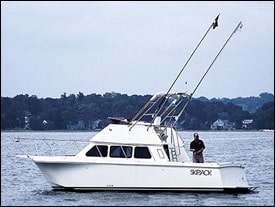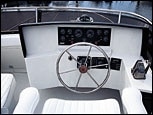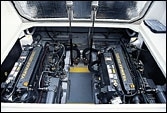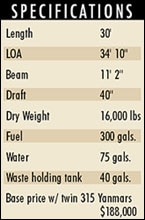
Unless you’ve done much boating and fishing in California, chances areyou haven’t heard of Skipjack boats. This is rather odd, seeingas how over 4,000 Skipjacks have been built since the companywas founded 33 years ago by Jack Cole. Cole was, and is, an avidfisherman who set out to design a boat that was rugged enoughto fish for marlin and swordfish off Southern California, yetsmall and manageable enough to trailer to Baja (and live on) whenthe fish weren’t biting at home. His plan eventually led to thecreation of the 20 Fly Bridge, a mini-sportfisherman that enjoyedsomewhat of a cult following among hardcore SoCal fishermen inthe ’60s. Cole quickly expanded the small-flybridge idea to anincredibly popular 24-foot model, of which over 1,000 have beensold.
Eight years ago, Skipjackintroduced its 26 Fly Bridge, which Mark McAnlis, Skipjack’s Vice-Presidentof Sales and Marketing, calls “the best trailerable boatin the 20- to 30-foot range – period.” The 26 was a naturalhit among owners of the 24, and in 1996 the company followed upon its success by making the big step into the 30-foot range withthe introduction of the 30 Fly Bridge.
McAnlis is a true believerin the Skipjack name. In fact, he sees it as his mission to letthe rest of the country know about these boats, which is why hehad two Skipjacks – a 26 and a 30 – shipped east to Connecticut’sNorwalk Boat Show last October. By the time I caught up with himafter the show, the 26 had been sold and several parties had expressedinterest in the 30.
Fishing Heritage

As McAnlis explains, the30 Fly Bridge was a natural step for Skip jack, a company whoseprinciple is building solid, seaworthy boats for people who spenda lot of time fishing and cruising. The fishing part of the equationis reflected in the 30’s large, uncluttered cockpit, which boasts75 square feet of open space. There’s a 21-inch-wide transom doorto starboard that leads to a wide swim platform supported by fourmassive stainless steel brackets.
The transom top containsa plumbed, 30-gallon bait tank and a ten-cubic-foot insulatedfishbox, both with spring-loaded lids. The raw-water washdownis located to starboard, and a hot/cold fresh water cockpit showeris optional. The cockpit is surrounded by standard padded coaming,and the entire deck is covered in grippy molded-in nonskid.
The cockpit sole raiseson hydraulic rams to provide wide-open access to the engines andother equipment, such as the three bilge pumps, fuel filters,batteries and optional generator. McAnlis points out that allsurfaces below are sanded, faired and gelcoated, which makes foreasy clean-up and a snag-free finish. Nice touch, but not surprisingwhen you consider the effort that goes into building a Skipjack.The hull is 100-percent hand-laid fiberglass, supported by a massivefore and aft spruce stringer system encapsulated in three-ouncemat and 24-ounce roving.

Back on deck, a welded,stainless ladder to starboard leads to the fly bridge, which offersexceptional visibility all around the boat. A huge storage compartmentis located behind the helm, and the passenger seat folds downto form a comfortable lounge. The console is laid out in a wraparoundfashion that affords easy viewing of all gauges, and there islots of room for flush-mounting electronics.
Moving forward, I reallyliked the level bow, which also is covered in molded nonskid andsurrounded by a welded, waist-high rail. The entire area is cleanand uncluttered, making for an incredibly stable platform- somethinganyone who loves scrambling to the bow and casting to fish willappreciate. McAnlis made special note of the sturdy pulpit, whichis five inches thick at its base and features a toe rail; no doubtit was designed by someone who liked casting baits to marlin andswordfish.
I got a chance to testthe pulpit first-hand when McAnlis and I made a brief run intoLong Island Sound and stopped to fish a rip. No bluefish or striperswere home, but it was a good opportunity for McAnlis to provehow stable the 30 is in water.

We also spent some timecruising around the Sound to see how the boat runs. Weighing inat 16,000 pounds (dry weight), the 30 has a solid feel at anyangle to the sea, although the one-foot chop we were faced withwasn’t exactly a fair test of performance. According to Skipjack’sfactory tests, the 30 hits a top speed of 35 mph at a wide-open3300 rpm with the standard 315 Yanmars. Recommended cruise is25 knots at 3100 rpm, and range is 450 miles with 300 gallonsof fuel.
The 30’s hull featuresa sharp entry to reduce pounding, and a “full” bow sectionthat allows the boat to track straight in a following sea. Doublestrakes increase lift for planing at lower speeds, while the reversebow flare and chine deflect spray for a dry ride.
As mentioned, Skipjacksare designed for people who like to spend a lot of time on theirboats, so the company doesn’t skimp on the belowdecks amenities.Overall, the cabin is very roomy and bright, thanks to its 6’6″ headroom and numerous windows. A double berth is locatedin the bow, and there’s a long settee to starboard that convertsto form a second double berth. Ample storage space is locatedbelow and behind the settee, including room for several big-gameoutfits.
Standard galley featuresinclude a microwave, a refrigerator, and a two-burner electric/alcoholstovetop. The head is located against the aft cabin bulkhead andfeatures Corian countertops and a stainless sink with removableshower head.
Of course, these arebut a few of the many features Skipjack packs into the 30. Tosee the rest you’ll just have to check one out yourself, whichshould be a lot easier once McAnlis achieves his goal of establishingdealerships along the East Coast. In fact, shortly after our boattest he signed on his first Northeast dealership – Oak dale YachtSales in Oakdale, New York. Oakdale had agreed to sell the 30Fly Bridge we tested, which makes one more Skipjack that won’tbe making a return trip to California.
_Skipjack International,Anaheim, CA; (714) 992-5388; (714) 992-5746 (fax). www.skipjackboats.com._Circle No. 202 on Reader Service Card.









